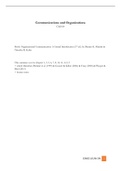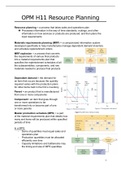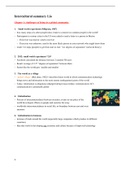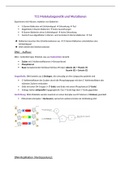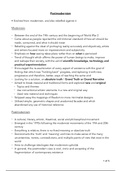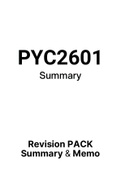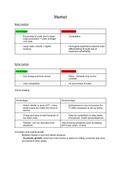Communications and Organizations
CM1014
Book: Organizational Communication: A Critical Introduction (2nd ed.) by Dennis K. Mumby &
Timothy R. Kuhn
This summary covers: chapter 1, 3, 5, 6, 7, 8, 10, 11, 12, 13
+ article Marschan-Piekkari et al. (1999) & Gossett & Kilker (2006) & Tracy (2000) & Ploeger &
Bisel (2013)
+ lecture notes
ESMEE LIEUW ON 1
,Chapter 1: What is Organizational Communication?
Human beings are communicating, organizing creatures, and we define ourselves largely through
our various organizational memberships and communicative connections
Organizations and communication processes that create them are essential to our self-definition
and sense of being-in-the-world, but we navigate them without really paying much attention to
how they give meaning to our lives
Organizations recognize that their ability to shape meaning and social reality through
communication processes is fundamental to their continued success.
Time, Space and the Emergence of the Modern Organization
• The shift from a society consisting of ‘workers’ to one of ‘managers’ and ‘employees’ is
key to understanding the historical transformations that led to the emergency of an
organizational society → change in types of jobs, beliefs, values and cultural practices
• British historian E.P. Thompson (1967) identifies the shift from task time (organic
sense of time where work is shaped by the demands of the tasks to be performed) to
clock time (time becomes form of currency, task is not dominant but value of time for
which employer pays the worker) as being a defining feature in the emergence of
industrial capitalism
• Clock time was crucial for mass production and a means of controlling a workforce for
whom independent work was the norm & made systematic exploitation of labor possible
• Generally speaking, the more one is considered a professional, the less one is tied to
clock time and the more one is invested in the nature of the tasks one performs
• The issue of control figures prominently as factory owners increasingly tried to dictate
employees’ relationship to work
• In order for organizations to function as collective, coordinated, goal-oriented social
structures, fundamental shifts had to occur in experience and meaning of work
Organizations as Communicative Structure of Power
• One of the defining features of an organization is that it coordinates the behaviors of its
members so they can work collectively, but very complicated to achieve in practice
• Joanne Ciulla (2000): “the struggle for freedom and power or control has long been the
struggle between masters and slaves, lords and serfs, and employees and employers. It is
the central problem of work.”
Esmée Lieuw On
2
,Tensions Between Employee Autonomy and Organizational Control
Employee goals Organizational Goals
Maximizing salary → Minimizing costs
Job stability → Organizational flexibility and
change
Maximizing leisure time → Maximizing work time
Behaving spontaneously → Behaving predictably
Asserting individual values → Asserting collective values
Developing personal → Developing professional
relationships relationships
Creativity → Efficiency
Relaxing the labor process → Intensifying the labor process
• These tensions have to be resolved, and generally speaking, get resolved in ways that are
consistent with organizational rather than individual goals
• Organizational control is never a simple cause-effect phenomenon, it often produces
creative employee responses that produce unintended outcomes for the organization →
when we describe organizations as communicative structures of power, we are talking
about how the tensions above play out dynamically through various communication
processes
Defining Organizational Communication
• W. Charles Redding (1988) (founder of field of organizational communication) argues
that all complex organizations exhibit four essential features:
1) Interdependence
2) Differentiation of tasks and functions
3) Goal orientation
4) Control
Communication was not included, but will be (5) Communication-Organization Relationship
5. Communication-Organization Relationship
• There are a number of ways to think about communication-organization relationship,
but two have been particularly influential:
1) Communication in organizations (views organizations as relatively stable, physical
structures within which communication occurs)
▪ Limitations:
a) by treating communication as information transmitter, it downplays
significance of communication in optimal performance of organizations
b) overlooks complexity of communication processes
c) we have a sense of who we are, our connections to others and our place
in the world
Esmée Lieuw On
3
, d) information transmission view of communication is a problem because it
tends to treat organizations as a given
2) Organizations as communication (argues that communication constitutes
organization, which means communication activities are the basic, defining ‘stuff’ of
organizational life
▪ Without communication, organizations cease to exist as meaningful human
collectives
▪ Organizations are seen as communicative phenomena
▪ Communication does not describe an already existing reality but creates a
social reality → we can define communication (the dynamic, ongoing
process of creating and negotiating meanings through interactional symbolic
(verbal and nonverbal), including conversation , metaphors, rituals, stories,
dress and space) and organizational communication (the process of
creating and negotiating collective, coordinated systems of meaning through
symbolic practices oriented toward the achievements of organizational goals)
1. Interdependence
• Organizations exhibit interdependence insofar as no member can function without
affecting, and being affected by, other organization members
• All complex organizations consist of intricate webs of interconnected communication
activities, the integration of which determines success/failure
2. Differentiation of Tasks and Functions
• All organizations operate according to the principle of division of labor in which
members specialize in particular tasks and the organization as a whole is divided into
various departments
3. Goal Orientation
• Non-profit or profit, organizations are oriented toward particular goals and those goals
are what provide an organization its particular character
• Barnard (1938) says that an organization comes into being when there are persons able to
communicate with each other, who are willing to contribute to action and to accomplish
a common purpose
4. Control
• Organizational control is not problematic, but can have negative consequences for
employees
• Redding (1988) presents two forms of control: hierarchy and authority, but here will be
looking at five different control processes that have emerged since late 19th century (was
as a response to employees’ efforts to exercise autonomy)
1) Direct Control
▪ Directing employees in explicit ways and monitor their behavior to ensure
adequate performance
Esmée Lieuw On
4
CM1014
Book: Organizational Communication: A Critical Introduction (2nd ed.) by Dennis K. Mumby &
Timothy R. Kuhn
This summary covers: chapter 1, 3, 5, 6, 7, 8, 10, 11, 12, 13
+ article Marschan-Piekkari et al. (1999) & Gossett & Kilker (2006) & Tracy (2000) & Ploeger &
Bisel (2013)
+ lecture notes
ESMEE LIEUW ON 1
,Chapter 1: What is Organizational Communication?
Human beings are communicating, organizing creatures, and we define ourselves largely through
our various organizational memberships and communicative connections
Organizations and communication processes that create them are essential to our self-definition
and sense of being-in-the-world, but we navigate them without really paying much attention to
how they give meaning to our lives
Organizations recognize that their ability to shape meaning and social reality through
communication processes is fundamental to their continued success.
Time, Space and the Emergence of the Modern Organization
• The shift from a society consisting of ‘workers’ to one of ‘managers’ and ‘employees’ is
key to understanding the historical transformations that led to the emergency of an
organizational society → change in types of jobs, beliefs, values and cultural practices
• British historian E.P. Thompson (1967) identifies the shift from task time (organic
sense of time where work is shaped by the demands of the tasks to be performed) to
clock time (time becomes form of currency, task is not dominant but value of time for
which employer pays the worker) as being a defining feature in the emergence of
industrial capitalism
• Clock time was crucial for mass production and a means of controlling a workforce for
whom independent work was the norm & made systematic exploitation of labor possible
• Generally speaking, the more one is considered a professional, the less one is tied to
clock time and the more one is invested in the nature of the tasks one performs
• The issue of control figures prominently as factory owners increasingly tried to dictate
employees’ relationship to work
• In order for organizations to function as collective, coordinated, goal-oriented social
structures, fundamental shifts had to occur in experience and meaning of work
Organizations as Communicative Structure of Power
• One of the defining features of an organization is that it coordinates the behaviors of its
members so they can work collectively, but very complicated to achieve in practice
• Joanne Ciulla (2000): “the struggle for freedom and power or control has long been the
struggle between masters and slaves, lords and serfs, and employees and employers. It is
the central problem of work.”
Esmée Lieuw On
2
,Tensions Between Employee Autonomy and Organizational Control
Employee goals Organizational Goals
Maximizing salary → Minimizing costs
Job stability → Organizational flexibility and
change
Maximizing leisure time → Maximizing work time
Behaving spontaneously → Behaving predictably
Asserting individual values → Asserting collective values
Developing personal → Developing professional
relationships relationships
Creativity → Efficiency
Relaxing the labor process → Intensifying the labor process
• These tensions have to be resolved, and generally speaking, get resolved in ways that are
consistent with organizational rather than individual goals
• Organizational control is never a simple cause-effect phenomenon, it often produces
creative employee responses that produce unintended outcomes for the organization →
when we describe organizations as communicative structures of power, we are talking
about how the tensions above play out dynamically through various communication
processes
Defining Organizational Communication
• W. Charles Redding (1988) (founder of field of organizational communication) argues
that all complex organizations exhibit four essential features:
1) Interdependence
2) Differentiation of tasks and functions
3) Goal orientation
4) Control
Communication was not included, but will be (5) Communication-Organization Relationship
5. Communication-Organization Relationship
• There are a number of ways to think about communication-organization relationship,
but two have been particularly influential:
1) Communication in organizations (views organizations as relatively stable, physical
structures within which communication occurs)
▪ Limitations:
a) by treating communication as information transmitter, it downplays
significance of communication in optimal performance of organizations
b) overlooks complexity of communication processes
c) we have a sense of who we are, our connections to others and our place
in the world
Esmée Lieuw On
3
, d) information transmission view of communication is a problem because it
tends to treat organizations as a given
2) Organizations as communication (argues that communication constitutes
organization, which means communication activities are the basic, defining ‘stuff’ of
organizational life
▪ Without communication, organizations cease to exist as meaningful human
collectives
▪ Organizations are seen as communicative phenomena
▪ Communication does not describe an already existing reality but creates a
social reality → we can define communication (the dynamic, ongoing
process of creating and negotiating meanings through interactional symbolic
(verbal and nonverbal), including conversation , metaphors, rituals, stories,
dress and space) and organizational communication (the process of
creating and negotiating collective, coordinated systems of meaning through
symbolic practices oriented toward the achievements of organizational goals)
1. Interdependence
• Organizations exhibit interdependence insofar as no member can function without
affecting, and being affected by, other organization members
• All complex organizations consist of intricate webs of interconnected communication
activities, the integration of which determines success/failure
2. Differentiation of Tasks and Functions
• All organizations operate according to the principle of division of labor in which
members specialize in particular tasks and the organization as a whole is divided into
various departments
3. Goal Orientation
• Non-profit or profit, organizations are oriented toward particular goals and those goals
are what provide an organization its particular character
• Barnard (1938) says that an organization comes into being when there are persons able to
communicate with each other, who are willing to contribute to action and to accomplish
a common purpose
4. Control
• Organizational control is not problematic, but can have negative consequences for
employees
• Redding (1988) presents two forms of control: hierarchy and authority, but here will be
looking at five different control processes that have emerged since late 19th century (was
as a response to employees’ efforts to exercise autonomy)
1) Direct Control
▪ Directing employees in explicit ways and monitor their behavior to ensure
adequate performance
Esmée Lieuw On
4



